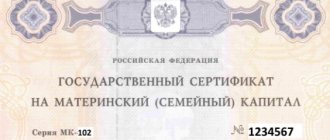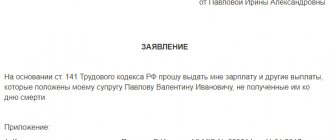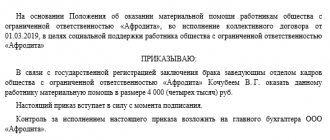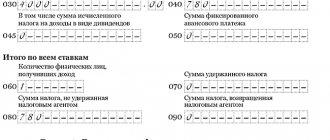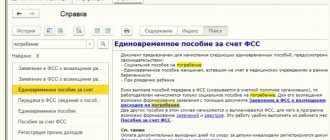Personal income tax with financial assistance in 2018
Natural disaster, terrorist act Such financial assistance will not be subject to personal income tax, regardless of the amount.
Accrued funds also do not need to be reflected in the 2-NDFL certificate (see Letter from the Ministry of Finance). Treatment Let's say an employee was paid 50,000 rubles. In this case, only 4,000 rubles are not subject to taxation. Accordingly, such a payment will be subject to personal income tax from 46,000 rubles. The tax amount (13% of the amount 46,000) will be 5,980 rubles. The funds that the employee will receive will amount to 44,020 rubles. The 2-NDFL certificate will be reflected with codes: income - 2770 and deductions - 504. The income and deduction codes for filling out the 2-NDFL certificate are given in Order of the Federal Tax Service of Russia dated September 10, 2015 No. MMV-7-11/ (as amended on November 22. 2016).
- Code 2710 - used to reflect any type of financial assistance, including that whose amount does not exceed 4,000 rubles, with the exception of:
- Code 2760 - used to reflect financial assistance to retired workers.
- Code 2761 - used to reflect financial assistance to disabled people, provided that it is provided by public organizations and not by the employer.
- Code 2762 - reflects financial assistance, which is paid at the birth of children or upon their adoption.
- financial assistance to retired employees (due to old age or disability);
- financial assistance for the birth or adoption of children;
- financial assistance provided to disabled people by public organizations.
So, we have looked at all types of income codes and deductions that are indicated in the 2-NDFL certificate when paying financial aid.
In fact, such an exemption is nothing more than a type of property tax deduction. Both income and deductions have special codes. The material assistance code in the 2-NDFL certificate and deduction codes are reflected by personnel employees or other responsible persons.
Next, we’ll figure out what the income codes are. assistance, and by what regulatory act they are established. Income code - material assistance up to 4,000 rubles Income codes for material assistance are reflected in the Order of the Federal Tax Service of Russia dated September 10, 2015 No. ММВ-7-11/ The income code for material assistance of 4,000 rubles or less is entered in the 2-NDFL certificate. The codes are indicated in Appendix No. 1 to the above Order of the Federal Tax Service. Guided by the requirements of this order, specific income codes - financial assistance, as well as deduction codes for financial assistance of 4,000 rubles or less, entered in the 2-NDFL certificate, depend on the amount of payment and the purpose of such support (i.e., the type of financial assistance). When the total support paid to an employee does not exceed 4,000 rubles (for any type of financial assistance), the deduction code is as follows: 503. When financial assistance is paid in connection with the birth (adoption) of a child, deduction code 508 is entered. No other deduction codes are currently established. Material assistance: income code in the 2-NDFL certificate. Entering the income code on the material assistance received in the 2-NDFL certificate is carried out in accordance with the requirements of the already mentioned order No. MMV-7-11/387.
Rules for reflecting financial aid in 2-NDFL
The Tax Code establishes different procedures for taxing financial aid with personal income tax depending on the reason for which it is paid or what “type” this financial aid is. Conventionally, all financial assistance can be divided into 2 groups: limited by the amount not subject to personal income tax and unlimited.
So, any financial assistance that is not subject to personal income tax in a certain amount must be reflected in the 2-personal income tax certificate. It is necessary to show the entire amount of income in the form of financial assistance and the deduction applied to it (in the amount not subject to personal income tax).
For example, in 2-NDFL, financial assistance up to 4,000 rubles paid to an employee (clause 28 of Article 217 of the Tax Code of the Russian Federation) must be shown with income code 2760 and at the same time with deduction code 503. Similarly, the certificate indicates a lump sum payment accrued to the employee in connection with the birth of his child. As you know, it is not subject to personal income tax up to 50 thousand rubles. for each child, but for both parents, and provided that it is paid within a year from the date of birth. For this financial assistance, income code 2762 and at the same time deduction code 504 are used (Appendices No. 1, No. 2 to the Order of the Federal Tax Service of September 10, 2015 No. MMV-7-11 / [email protected] ).
But financial assistance, which is not subject to personal income tax regardless of its size, is not indicated at all in 2-personal income tax. For example, there is no need to reflect in the certificate the payment of one-time assistance to an employee whose apartment burned down for reasons beyond his control. After all, it was paid due to an emergency circumstance, which means it is completely not subject to personal income tax (clause 8.3 of Article 217 of the Tax Code of the Russian Federation).
Application for financial assistance in connection with the birth of a child
The main document on the basis of which financial assistance is allocated in connection with the birth of a child is the application of the parent-employee of the enterprise (a sample is presented below).
- the application is written personally by the parent-employee of the organization;
- Handwritten as well as typewritten forms of document submission are acceptable (if there is a personal signature with a transcript);
- availability of basic details;
- correct statement of the essence of the request.
Typically, such statements are written in the personnel department or secretariat, whose employees can provide advice on writing.
The application must contain the following information:
- name of the employing organization;
- details of the manager (full name, position);
- applicant details (full name, position);
- statement of the situation, financial request;
- desired amount of financial assistance;
- date of document preparation;
- signature;
- application.
Payment classification
All required benefits are conditionally divided into mandatory and optional. Mandatory payments contain all types of assistance that are paid by the state. Optional - paid by the organization where the expectant mother works, in other words, this is financial assistance paid by the company to its employee on a voluntary basis.
There is also a difference: one-time payments and benefits that are paid monthly.
In addition, cash benefits are:
- federal (received by all citizens of the Russian Federation from the country’s budget);
- regional (the region has the right to issue additional benefits from its budget).
From the state
A lump sum payment upon the birth of a child is due once. It is possible for both the father and mother of a newborn to receive it. Every woman receives the payment, regardless of her employment before maternity leave. An unemployed woman can also receive this money.
The following documents are needed:
- statement;
- child's birth certificate;
- parents' passports;
- certificate from the other parent’s place of work;
- child's birth certificate and copy.
Documents for download (free)
- Sample application from an employee for financial assistance
The law allows 10 days for the calculation and issuance of money from the moment the package of documents is transferred to the accounting department at the address of work or study of a family member.
For child care
This subsidy is available to those who plan to take parental leave for up to 1.5 years. This could be any of the spouses. If an unemployed parent plans to provide care, you can do everything necessary to receive funds at the nearest branch of the Federal Social Insurance Fund of the Russian Federation.
For a working citizen, the benefit is calculated in the amount of 40% of the average monthly salary, 2 years before the birth of the child are taken into account, the amount is paid every month.
According to the law, the amount should not be less than 4,465.20 rubles if this is the first child, and 6,284.65 rubles for subsequent children.
A woman who has never worked before the birth of a child has the right to a minimum level payment, for which she needs to visit the Social Insurance Fund office at her place of residence. If a woman, while on leave to care for her first child, goes on leave to care for her next child, she becomes entitled to a subsidy, which will consist of the amount of benefits for caring for the first child and the second.
The maximum amount should not be more than 100% of the average salary for the last 2 years and be less than the minimum amount.
It is important that in this case the woman has the right to count on either payment of benefits or maternity benefits.
The following documents are required:
- parents' passports;
- child's birth certificate;
- parents' work records;
- a certificate from the employment service stating that no payment was made (for the mother);
- certificate from place of work (study);
- personal account number in the Security Council of the Russian Federation;
- certificate of family composition.
Maternal capital
Maternity capital is paid once in the event of the birth of a second and/or next child in the family. If there is more than one child in a family, and they did not use the capital, then when the next one appears, the family can issue a payment.
In addition to the child’s mother, the father can also receive state payments if he remains the sole adoptive parent of the second or subsequent children.
It is important to understand that current legislation allows the use of this capital exclusively for the following purposes:
- Elimination of housing problems (buying an apartment or a larger house).
- Children's education. Capital is allowed to pay for the education of any of the children in the family. You can pay with the amount of maternity capital to study at the desired accredited educational institution in the Russian Federation.
- Compensation for expenses for disabled children.
- To pay for the pension of the child’s mother, its funded part.
The use of capital for other needs is punishable by Russian law and is criminally punishable.
Maternity capital is registered at the Pension Fund branch. You are allowed to submit a package of documents at any convenient time. To receive capital, a personal certificate is required.
Basic documents for receiving funds:
- statement;
- parents' passports;
- children's birth certificate.
From the employer
An employer can pay financial assistance to employees upon the arrival of a child in the family; to do this, you need to write an application, to which you must attach the documents required by company regulations. But this payment is not mandatory and is paid solely at the request of the company. Therefore, the application will not necessarily receive a positive response.
The Labor Code does not provide for regulation of this payment. The conditions must be specified in the employment and collective agreement, and it must also indicate what documents must be attached to the application. As a rule, these should be:
- child's birth certificate;
- certificate of income of the second parent.
Taxation and contributions, deduction code
Tax deductions can also be considered one of the types of financial assistance. For example, the amount of financial assistance up to 50,000 rubles is not subject to personal income tax.
The employee has the right to independently decide whether to use this type of assistance or not. The employee must also provide documents independently. The limit on the standard deduction in 2018 was 391,454.79 rubles. If the total income from the beginning of the year is more than this amount, then the right to deduction disappears.
Also, for the first and second child, you can receive a deduction in the amount of 1,400 rubles, for the third and subsequent children, a deduction of 3,000 rubles.
In addition, insurance premiums are not charged for financial assistance for the birth of a child; the non-taxable amount is 50,000 rubles.
The employer submits a 2-NDFL certificate to the inspectorate - the deduction for the child is indicated in it as a separate line for each employee. To fill out the certificate, tax deduction codes for children are used (they are detailed in the Order of the Federal Tax Service of the Russian Federation).
For example, the deduction code for the first child is 126, for the second - 127, for the third and next - 129, for a disabled child under 18 years old (provided that he is studying full-time, then from 18 to 24 years old, from I or II disability group) - code 129.
Sample payment order
Basic requirements when filling out a payment order:
- Payer status – the person making the payment (01 – legal entity; 02 – tax agent, etc.).
- When indicating tax payments in the fields provided, you should carefully fill in the account numbers and bank names.
- Priority of payment (for tax contributions - 5).
- BCC (104) must be indicated as valid at the time of payment.
- OKTMO code – indicated at the location of the legal entity.
- The period for which the insurance or tax contribution is paid.
The form of the payment order does not change; the only thing that differs when transferring insurance premiums in case of disability due to maternity is the KBC.
Insurance premiums in case of disability due to maternity are paid according to KBC 182 1 02 02090 07 1010 160 from January 2021.
Can both parents receive financial assistance?
According to current legislation, both parents can receive financial assistance from the employer, but it is important not to forget that the non-taxable amount of 50,000 rubles consists of total birth benefits.
What to do if management refuses to pay financial assistance?
The fact is that a financial payment from an employer is voluntary assistance from an organization. This payment is not regulated by the Labor Code, so the employer has every right not to pay it.
Is it possible to receive payment before the birth of the child?
No, the payment is made only after the birth of the child, and the basis is a document confirming the birth.
How to get financial assistance for the birth of a child
To receive financial assistance from the employer, the employee must take the initiative.
Algorithm of actions:
- Drawing up an application for financial assistance (at the birth of a child, each parent has the right to ask the employer for feasible support).
- Providing the necessary documents (birth certificate or certificate from the registry office).
- Pending consideration of the case (the manager personally makes a decision or convenes a special commission consisting of a representative of the trade union, accounting department, and human resources department).
- Issuing an order to provide financial assistance.
- Receiving money (cash through the company's cash desk, bank transfer).
Accounting entries
When paying out financial assistance, the postings may differ; it depends only on the source of the payment.
In the case when these payments are made from retained earnings from previous years:
Dt 87 Kt 73 (76) It must be remembered that retained earnings can be transferred to provide financial assistance to employees only with the consent of the founders or shareholders of the company.
If the current year’s profit is used for financial assistance:
Dt 91.2 Kt 73 (76)
The founders' permission is not required. Such a decision can be made by the management of the organization.
Financial assistance issued:
Dt 73 (76) Kt 50 (51)
At the birth of a child, a woman has the right to financial assistance both from the organization in which she works and from the state. Even if a woman has never worked before having a child, she can count on financial support from the state.
Of course, these cash receipts will not solve the financial issue once and for all, but, nevertheless, they will serve as a good help. After all, right after birth it is necessary to purchase a lot of things necessary for the child. Therefore, it is important to know your rights and timely collect and submit the necessary documents for each payment location.
Fresh materials
- Clarification on 4 FSS When it is necessary to adjust 4-FSS The calculation presented in the FSS in form 4-FSS does not need adjustments if...
- Social tax 2021 Tax accrualIn accounting, the amounts of advance tax payments are reflected in the credit of account 69 (68)…
- Tax planning Tax planning in an organization Tax planning can significantly affect the formation of the financial results of an organization,…
- Why do they buy gold? Selling gold competently is a process that will require you to spend some free time. It will be necessary to find out...
Financial assistance for the birth of a child in 2021: application and postings
Dt 84 – Kt 73(76) Note that it is possible to use retained earnings to provide financial assistance from the employer at the birth of a child only with the permission of the founders or participants/shareholders of the company, adopted at the general meeting. Accordingly, when an organization has a single founder, a general meeting is not held.
If the pregnancy progresses well and the birth is normal, she will be given a certificate of temporary incapacity for work for 2 months before giving birth and for three months after. And if complications arise during labor and delivery, sick leave is issued for a larger number of days.
We recommend reading: How to Get Income Tax on a Car Purchase
